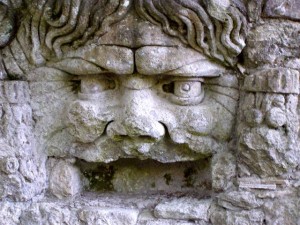
Il Sacro Bosco is a wierd and perplexing garden set in a ravine below the town of Bomarzo in the Sabine Hills. The Orsini palace, scowling above, is built on an outcrop of tufa, the local volcanic rock. Below it, hidden in a fold of the land, a collection of giant statues carved out of the living rock. Included are the beautiful and the grotesque.
The garden was made by one Vicino Orsino. Working as a condottiere or soldier of fortune, he had amassed wealth and returned home. His wife died shortly afterwards and his garden was made as a tribute of love to her. Vicino had literary tastes and the carvings are , so it is said, inspired by the description of Arcadia in Virgil's Aeneid.
The date was 1552 - just fifty years after Cesare Borgia's iron-gloved
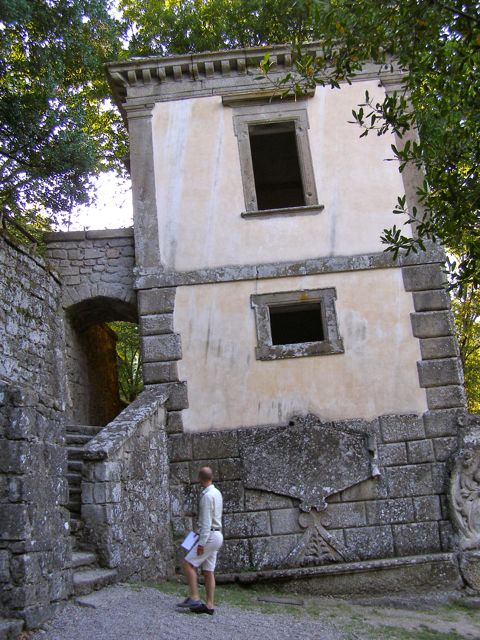
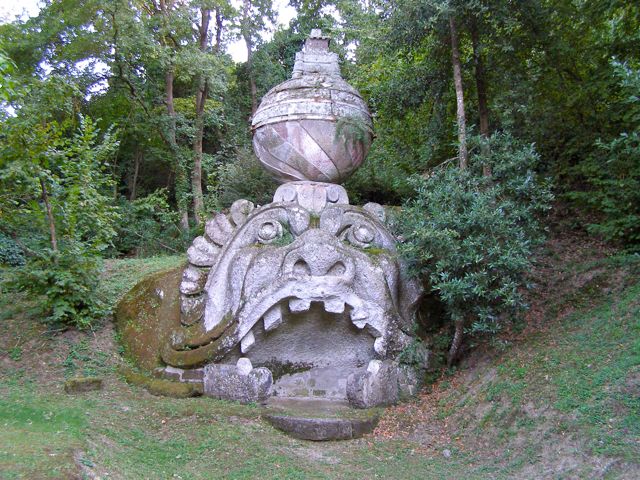
attempt to exterminate the Orsini family. Not far from Bomarzo, in Citta della Pieve, Borgia had had 3 of Vicino's uncles strangled as he made his way to the Carnival in Rome. Cardinal Orsini had been thrown into a dungeon and then poisoned by Cesare's father, the pope Alexander VI. Orsini palaces in Rome had been ransacked and pillaged.
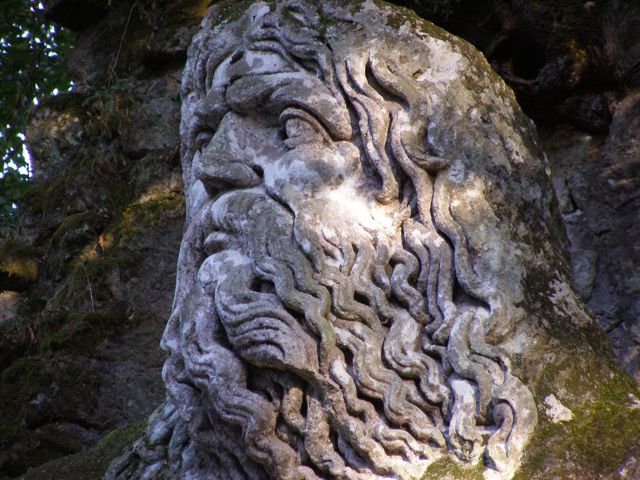
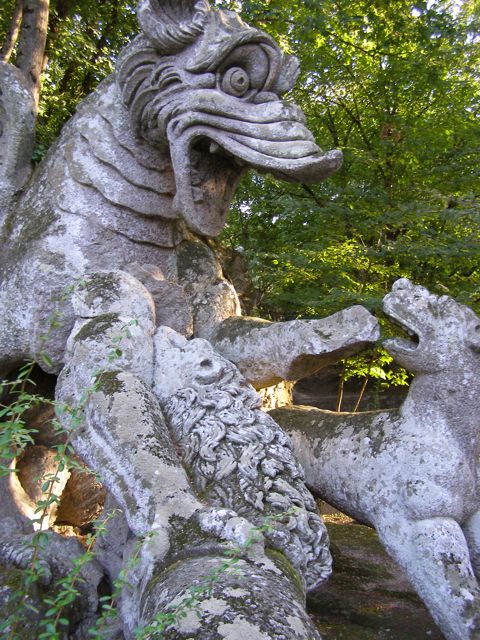
The might of the Orsini was seriously dented and Vicino had linked his fortune to the rising stars by marriage to a Farnese. Pope Pius III was Alessandro Farnese. The aristocratic roman families jockeyed for power. And consolidating it through the pontificate was the best way. The Borgias, upstarts from Spain had tried to carve themselves permanent estates in Italy but the death of Cesare's father put a stop to this.

Just a few miles away, by crow flight, the Farnese Cardinal Odorado and Vicino's father-in-law had built a massive pentagonal fortress dominating and holding spooky sway over the hill town of Caprarola. Above it, a path through woodland breaks out into a pair of grottoes, a water staircase and a loggia and terrace for parties. Near it in turn, is Bagnaia and the Villa Lante, described as "the consummate example of the best period in garden history" The symmetry is rigorous with the house built to fit in with the perfect garden proportions.
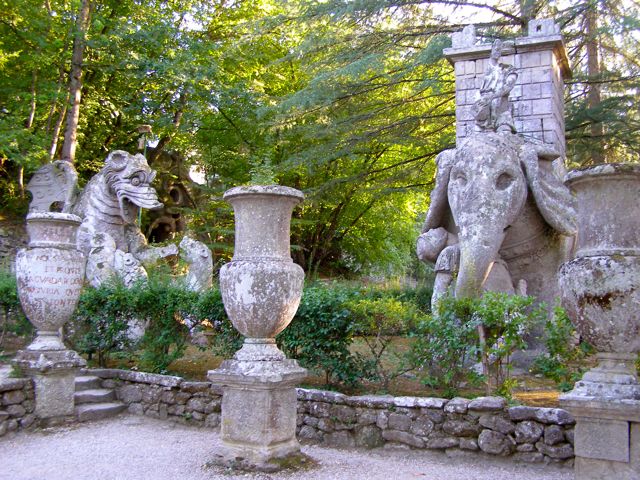
Il Sacro Bosco has none of this. The giant sculptures take their place where the rock was found. The random lack of symmetry has a tongue in cheek appeal that gets very far away from the grandiose and egotistical.
The garden did not survive its maker and spent centuries hiding behind curtains of brambles and other weeds. In the 1950s the land changed hands and its awesome giants and strange hidden meanings have turned it into a cult garden. Salvador Dali loved it. Go and walk as if in a dream.
 Il Sacro Bosco is a wierd and perplexing garden set in a ravine below the town of Bomarzo in the Sabine Hills. The Orsini palace, scowling above, is built on an outcrop of tufa, the local volcanic rock. Below it, hidden in a fold of the land, a collection of giant statues carved out of the living rock. Included are the beautiful and the grotesque.
The garden was made by one Vicino Orsino. Working as a condottiere or soldier of fortune, he had amassed wealth and returned home. His wife died shortly afterwards and his garden was made as a tribute of love to her. Vicino had literary tastes and the carvings are , so it is said, inspired by the description of Arcadia in Virgil's Aeneid.
The date was 1552 - just fifty years after Cesare Borgia's iron-gloved
Il Sacro Bosco is a wierd and perplexing garden set in a ravine below the town of Bomarzo in the Sabine Hills. The Orsini palace, scowling above, is built on an outcrop of tufa, the local volcanic rock. Below it, hidden in a fold of the land, a collection of giant statues carved out of the living rock. Included are the beautiful and the grotesque.
The garden was made by one Vicino Orsino. Working as a condottiere or soldier of fortune, he had amassed wealth and returned home. His wife died shortly afterwards and his garden was made as a tribute of love to her. Vicino had literary tastes and the carvings are , so it is said, inspired by the description of Arcadia in Virgil's Aeneid.
The date was 1552 - just fifty years after Cesare Borgia's iron-gloved
 attempt to exterminate the Orsini family. Not far from Bomarzo, in Citta della Pieve, Borgia had had 3 of Vicino's uncles strangled as he made his way to the Carnival in Rome. Cardinal Orsini had been thrown into a dungeon and then poisoned by Cesare's father, the pope Alexander VI. Orsini palaces in Rome had been ransacked and pillaged.
attempt to exterminate the Orsini family. Not far from Bomarzo, in Citta della Pieve, Borgia had had 3 of Vicino's uncles strangled as he made his way to the Carnival in Rome. Cardinal Orsini had been thrown into a dungeon and then poisoned by Cesare's father, the pope Alexander VI. Orsini palaces in Rome had been ransacked and pillaged.

 The might of the Orsini was seriously dented and Vicino had linked his fortune to the rising stars by marriage to a Farnese. Pope Pius III was Alessandro Farnese. The aristocratic roman families jockeyed for power. And consolidating it through the pontificate was the best way. The Borgias, upstarts from Spain had tried to carve themselves permanent estates in Italy but the death of Cesare's father put a stop to this.
The might of the Orsini was seriously dented and Vicino had linked his fortune to the rising stars by marriage to a Farnese. Pope Pius III was Alessandro Farnese. The aristocratic roman families jockeyed for power. And consolidating it through the pontificate was the best way. The Borgias, upstarts from Spain had tried to carve themselves permanent estates in Italy but the death of Cesare's father put a stop to this.
 Just a few miles away, by crow flight, the Farnese Cardinal Odorado and Vicino's father-in-law had built a massive pentagonal fortress dominating and holding spooky sway over the hill town of Caprarola. Above it, a path through woodland breaks out into a pair of grottoes, a water staircase and a loggia and terrace for parties. Near it in turn, is Bagnaia and the Villa Lante, described as "the consummate example of the best period in garden history" The symmetry is rigorous with the house built to fit in with the perfect garden proportions.
Just a few miles away, by crow flight, the Farnese Cardinal Odorado and Vicino's father-in-law had built a massive pentagonal fortress dominating and holding spooky sway over the hill town of Caprarola. Above it, a path through woodland breaks out into a pair of grottoes, a water staircase and a loggia and terrace for parties. Near it in turn, is Bagnaia and the Villa Lante, described as "the consummate example of the best period in garden history" The symmetry is rigorous with the house built to fit in with the perfect garden proportions.
 Il Sacro Bosco has none of this. The giant sculptures take their place where the rock was found. The random lack of symmetry has a tongue in cheek appeal that gets very far away from the grandiose and egotistical.
The garden did not survive its maker and spent centuries hiding behind curtains of brambles and other weeds. In the 1950s the land changed hands and its awesome giants and strange hidden meanings have turned it into a cult garden. Salvador Dali loved it. Go and walk as if in a dream.
Il Sacro Bosco has none of this. The giant sculptures take their place where the rock was found. The random lack of symmetry has a tongue in cheek appeal that gets very far away from the grandiose and egotistical.
The garden did not survive its maker and spent centuries hiding behind curtains of brambles and other weeds. In the 1950s the land changed hands and its awesome giants and strange hidden meanings have turned it into a cult garden. Salvador Dali loved it. Go and walk as if in a dream. 